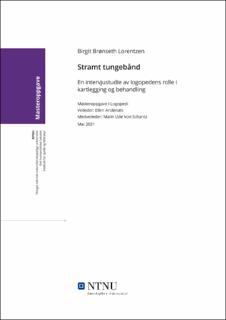| dc.contributor.advisor | Andenæs, Ellen | |
| dc.contributor.advisor | Schantz, Malin Ude Von | |
| dc.contributor.author | Lorentzen, Birgit Brønseth | |
| dc.date.accessioned | 2022-02-01T18:22:03Z | |
| dc.date.available | 2022-02-01T18:22:03Z | |
| dc.date.issued | 2021 | |
| dc.identifier | no.ntnu:inspera:80372130:14797245 | |
| dc.identifier.uri | https://hdl.handle.net/11250/2976439 | |
| dc.description.abstract | Tema og problemstilling: Tema for mitt prosjekt er stramt tungebånd, med fokus på logopedens rolle i kartlegging og behandling. Problemstillingen jeg har valgt er: Hvordan arbeider et utvalg logopeder i Norge med stramt tungebånd?
Bakgrunn: Stramt tungebånd, eller ankyloglossi som er den medisinske diagnosen, karakteriseres av begrenset bevegelighet av tungen som et resultat av en begrensning i tungebåndet. Forekomsten varierer fra 2,08 til 10,7 prosent. Bevissthet rundt stramt tungebånd, og problematikk knyttet til diagnosen, har økt de siste årene. I arbeidet med prosjektet har faglitteraturen vist at forskningen er av varierende kvalitet, og det mangler evidens for sammenheng mellom stramt tungebånd og utfordringer utover de knyttet til amming. Enighet rundt definisjon av diagnosen, og retningslinjer for kartlegging og behandling er også manglende. Som logopedstudent er dette et område man burde ha mer kunnskap om, likevel er ikke litteratur om temaet en del av pensum i utdanningen.
Formål: Målet mitt med denne oppgaven har vært å gi et innblikk i et utvalg logopeders vurderinger knyttet til kartlegging og behandling av personer med stramt tungebånd. Dette kan bidra til å gi kunnskap andre logopeder kan ha nytte av, og rette oppmerksomhet mot et felt som i Norge enda er ganske nytt.
Metode: Målet med prosjektet mitt var å komme i dybden av logopedenes erfaringer, opplevelser og vurderinger, og jeg valgte intervju som metode. Jeg intervjuet fem logopeder som alle hadde erfaring fra logopedisk oppfølging av personer med stramt tungebånd. Det ble gjort lydopptak av intervjuene, som så ble transkribert. Jeg benyttet stegvis-deduktiv induksjon som metode for å analysere datamaterialet.
Resultater og konklusjon: Gjennom arbeidet med prosjektet kom det frem at logopedene i undersøkelsen hadde tilfeldig eller ingen kunnskap om stramt tungebånd med seg fra utdanningen. Kunnskap om stramt tungebånd hadde de derfor tilegnet seg gjennom litteratur og kurs med utenlandske kolleger. Samtidig beskrives det i faglitteraturen at logopeden har en viktig rolle i det tverrfaglige arbeidet. Logopedene i studien var i stor grad enige om symptomer, og at stramt tungebånd kan påvirke områder som artikulasjon, svelging og utvikling av kjeve og tenner. Materialet viste også at logopedenes arbeid med fagområdet preges både av tilfeldig kunnskap og av utfordringer rundt det å bli hørt.
Stramt tungebånd er en diagnose som trenger mer forskning, og spesielt på områder som ikke er knyttet til amming. For å gi god oppfølging trengs kunnskap, standardiserte kartleggingsverktøy, og retningslinjer for behandling. | |
| dc.description.abstract | Topic and research question: The overall topic for my project is tongue-tie, focusing on the speech and language therapist’s role in assessment and treatment. The research question I chose was: How does a selection of speech and language therapists in Norway work with tongue-tie?
Background: Tongue-tie, or ankyloglossia which is the medical diagnosis, is characterized by limited mobility of the tongue as a result of restriction. The incidence varies from 2.08 to 10.7 percent. Awareness of tongue-tie, and problems related to the diagnosis have increased over the last years. Working with the project the literature has shown that the research is of varying quality, and there is a lack of evidence for connections between tongue-tie and other challenges beyond those related to breastfeeding. Agreement on the diagnosis, and guidelines concerning assessment and treatment are also lacking. As a speech and language therapy student, this is an area you should have more knowledge about, yet the literature on the topic is not part of the education’s curriculum.
Purpose: My goal with this thesis has been to provide an insight into a selection of speech and language therapist’s considerations related to assessment and treatment of people with tongue-ties. This can help to provide knowledge that other speech and language therapists can benefit from and draw attention to a field that is still fairly new in Norway.
Method: The goal of my project has been to get in depth of the speech and language therapists' experiences and considerations, and I chose interview as the method. I interviewed five speech and language therapists who all had experience from speech therapy follow-up of people with tongue-tie. Audio recordings were made of the interviews, which then were transcribed. I used a stepwise deductive inductive approach as a method for analysing the data material.
Results and conclusion: Working on the project, it emerged that the speech and language therapists in the study had random or no knowledge of tongue-tie from their education. Knowledge about tongue-tie they had acquired through literature and courses with colleagues from other countries than Norway. At the same time the literature describes the speech language therapist as having an important role in interdisciplinary work. The speech and language therapists in the survey largely agreed on symptoms, and that tongue-tie can affect areas such as articulation, swallowing and development of the jaw and teeth. The material also showed that the speech and language therapists' work within the subject is characterized by a random knowledge and challenges around being heard.
Tongue-tie is a diagnosis that needs more research, and especially in areas not related to than breastfeeding. To provide good follow-up, knowledge, standardized assessment tools and guidelines for treatment are needed. | |
| dc.language | nob | |
| dc.publisher | NTNU | |
| dc.title | Stramt tungebånd
- en intervjustudie av logopedens rolle i kartlegging og behandling | |
| dc.type | Master thesis | |
